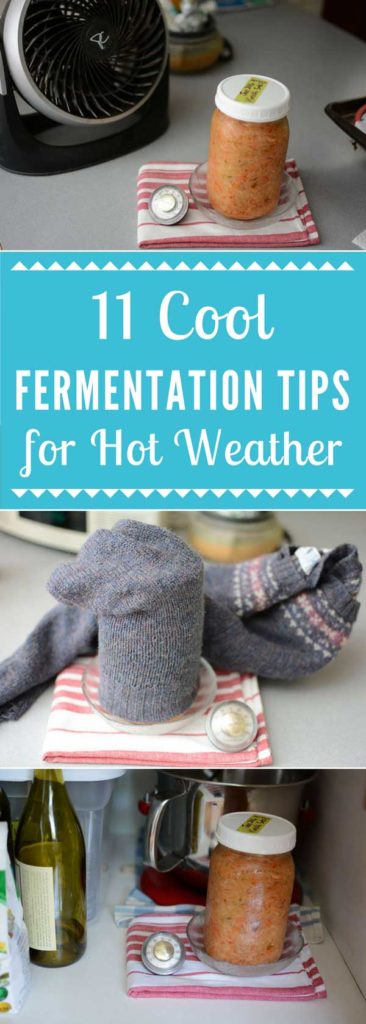Are you struggling with trying to ferment sauerkraut – or other vegetables – in hot weather? Many of my readers are. They keep ending up with moldy, mushy sauerkraut even though they are following instructions. My 11 fermentation tips will have you fermenting the good stuff in no time.
For successful fermentation, it is important to understand the three dials that need adjusting when fermenting sauerkraut: Salinity, Temperature, and Time. In this post, I cover the importance of the temperature dial with a set of fermentation tips to make the most of fermenting in hot weather.
If you’re battling with any of the following, it could be because you are fermenting in weather that is too hot for the various strains of bacteria that do the fermentation work for you.
- Soft and mushy sauerkraut or vegetables.
- Browned sauerkraut.
- The growth of molds and yeasts.
And, if you live in:
Dallol, Ethiopia,
Timbuktu, Mali,
Kebili, Tunisia,
Death Valley, United States or
Australia’s Badlands,
you have an even greater challenge. These places have some of the highest recorded temperatures in the world, many in excess of 120° F (49° C)!
What do people in these hot climates do to cool off?
They migrate to cooling bodies of water, put a cool cloth on the back of their neck or keep fans running. We will employ similar tactics for cooling your fermenting sauerkraut.
But first, let’s understand why fermentation in hot weather may not unfold in an ideal manner.
- Understand the Fermentation Process
- Check the Temperature of the Area Where Your Sauerkraut is Fermenting
- Fermentation Tips for Hot Weather
- Slightly Increase the Amount of Salt Used
- Ferment for a Shorter Time Period
- Find a Cooler Location
- Use the Air Conditioner or a Fan
- Take Advantage of Evaporative Cooling: The Wet T-Shirt Method
- Wet T-Shirt Method
- Insulate Your Ferment
- Use an Ice Chest to Make a Cool Chamber
- Use an Ice Chest to Make a Swamp Cooler
- Set Your Ferment on a Slab of Stone or Marble
- Ferment Seasonally
- Avoid the Use of Starter Cultures
- These fermentation tips should get you started on cooling down your fermenting sauerkraut. Share your successes, failures or ideas in the Comment Section, below.
Understand the Fermentation Process
Sauerkraut fermentation goes through three stages of fermentation with different strains of bacteria growing and working at each stage. You want to make sure that all of your microscopic friends have the environment they need to do their work.
The various bacteria strains are somewhat particular about the temperature of the room in which they are working. Some wilt in the heat. Others refuse to work if it gets too cold. Picky little buggers.
Ideal fermentation temperatures range from 65-72° F (18–22° C). According to biologists that have studied bacteria strains during the various stages of fermentation, the first 3 days are the most critical. It’s during this time period that you don’t want your fermentation spot to be much warmer than 72° F (22° C).
Before I share my fermentation tips for hot weather, first a quick coverage of the three stages of fermentation and the wonderful teams of bacteria that work for you.
Stage One: Leuconostoc mesenteroides, Days 0-3
The bubble-blowing, flavor team goes to work first. The L. mesenteroides bacteria of this stage wilt in the heat and refuse to work at temperatures much above 72° F (22° C). Hence, the need to get creative if you are fermenting in hot weather.
The job of the L. mesenteroides bacteria is to produce carbon dioxide that replaces the oxygen in your jar, making it anaerobic and producing the bubbles you see rising to the surface. Just what we want.
Stage Two: Lactobacillus plantarum & Lactobacillus cucumeris, Days 3-16
The sugar-busting team, Lactobacillus plantarum & Lactobacillus cucumeris, work during this two-week period, eating the sugars in the cabbage and vegetables and making lactic acid.
Lactic acid gives sauerkraut its characteristic tang and acts as a preservative.
The bacteria at this stage don’t work well in too salty or too cold of an environment. Therefore, don’t over salt your sauerkraut or expect it to ferment by placing it in the refrigerator.
Stage Three: Lactobacillus brevis & Lactobacillus pentoaceticus, Days 16-20
The finishing team, Lactobacillus brevis & Lactobacillus pentoaceticus, do their work during last few days of fermentation, rounding out the flavors and dropping the pH of your sauerkraut to a safe level (below 4.0).
Check the Temperature of the Area Where Your Sauerkraut is Fermenting
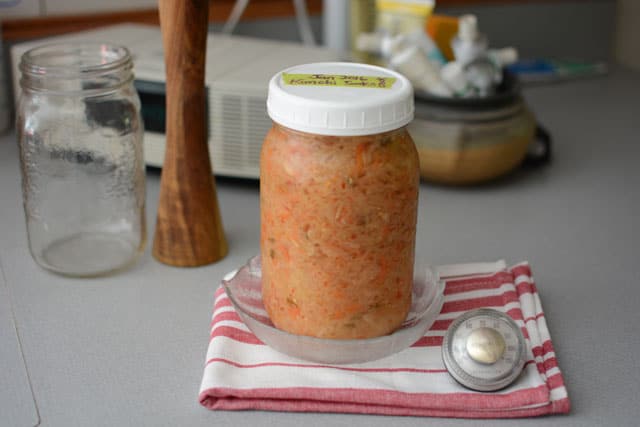
Until you get to know the temperatures in your home for the time of year you’re fermenting, it doesn’t hurt to actually take a temperature reading for the area where your sauerkraut in fermenting.
I have a household thermometer that I keep on the counter close to my fermenting jars. I find it useful to periodically glance at it and make sure the house is not too warm or too cold.
Place your thermometer where you think you will be fermenting and let it sit for 12-24 hours to get an accurate idea of the average temperature in that area. Stay away from areas that might have large temperature swings.
Depending on the type of thermometer you have, there are a couple different ways to do this.
Thermometer in Jar of Water
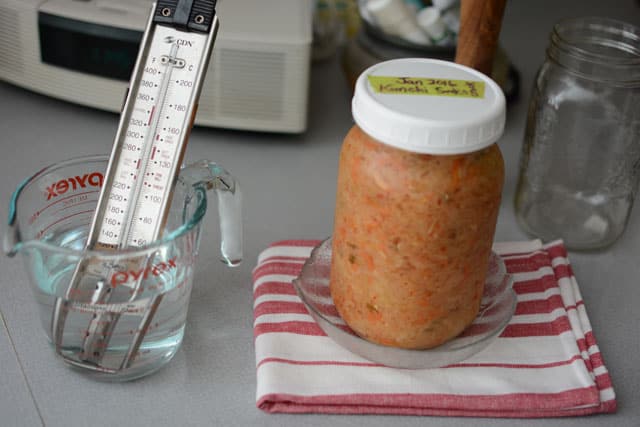
A thermometer in a measuring cup or jar of water placed where you’re fermenting is a simple way to get an accurate temperature reading.
Strip Thermometer
Inexpensive strip thermometers can be placed on the counter or taped to your jar to check temperatures. Beer and Kombucha brewers use these strips attached to their kegs or jars to monitor temperatures.
Even though strip thermometers come with adhesive backing, I recommend either temporarily taping it to your jar or just leaving it sitting on the counter next to your jar so it can be reused indefinitely.
Travel Alarm Clock with Thermometer
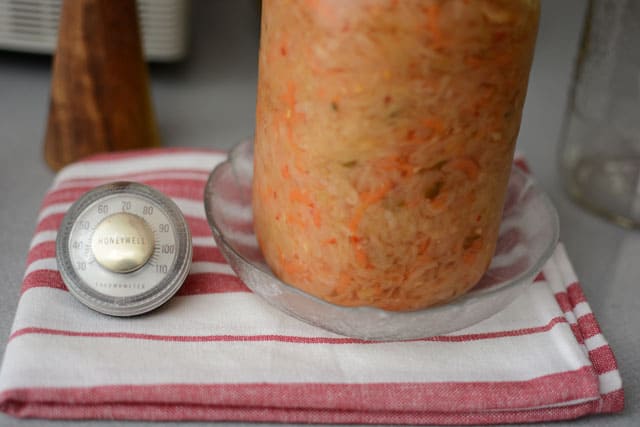
Most travel alarms come with thermometers. I’m lucky to have a vintage Honeywell thermometer that belonged to my husband’s family that serves the same purpose.
Just leave a thermometer on the counter near your jars of sauerkraut.
Fermentation Tips for Hot Weather
If your home is too warm, above 75°F (24°C), try one or more of the following fermentation tips for hot weather. Or, consider these bonus tips from my readers:
[su_testimonial name=”- Hugo” photo=”https://www.makesauerkraut.com/wp-content/uploads/2015/12/avatar-M1.png”]Get an old but still working refrigerator, the one you may have in the garage.
Take a look at the thermostat. Mostly there is a preset screw hidden somewhere. Screw in or out (depending on the thermostat) a couple of turns and check for the result.
The double door fridge that I use for fermenting and storage of green bananas now reaches a level of 18 C.
Ideal for cooling red wine… or fermenting sauerkraut!
[/su_testimonial]
[su_testimonial name=”- Tim from Placentia, California” photo=”https://www.makesauerkraut.com/wp-content/uploads/2015/12/avatar-M1.png”]It’s my 3rd year of fermenting, and I live in California. We had 2 years of scorching heat. I knew I had to fix the constant swinging of temps. I thought to myself, “how to keep temps around 65-70 all the time?” My final solution…..small electric wine cooler!!!
I now refer to it as my “cellar.” Yes, it’s marvelous! I do wish it would have a setting to go warmer than 66 degrees (F), but hey, it works! A cooler ferment takes a bit longer but tastes better anyway. Just did a batch of kraut last night, can’t wait….
P.S. If you want to use 2-quart bottles with an airlock, this was the only one I could find (Magic Chef – Model # MCWC12B). I can fit 4 of them with about 1/4″ space from the top of the airlock. Just enough room to breath! Works great. http://www.homedepot.com/p/Magic-Chef-12-Bottle-Wine-Cooler-in-Black-MCWC12B/204997292[/su_testimonial]
[su_testimonial name=”Matsumi from Arizona” photo=”https://www.makesauerkraut.com/wp-content/uploads/2016/01/avatar-M5.png”]I currently live in Arizona, and I discovered that even in the dry heat, the shade under the breeze provides an almost room temperature like breeze and cool air.
I placed my vegetables in a bush where it is safe from the heat and left it to ferment. It came out perfect. It actually tasted better than when it was inside the house. Just as the penguins use volcanoes for heat. So also in nature are there many things that provide a remedy when some element deems it necessary.
Just as the penguins use volcanoes for heat. So also in nature are there many things that provide a remedy when some element deems it necessary.[/su_testimonial]
[su_dropcap style=”simple” size=”1″ class=”green”]1[/su_dropcap]
Slightly Increase the Amount of Salt Used
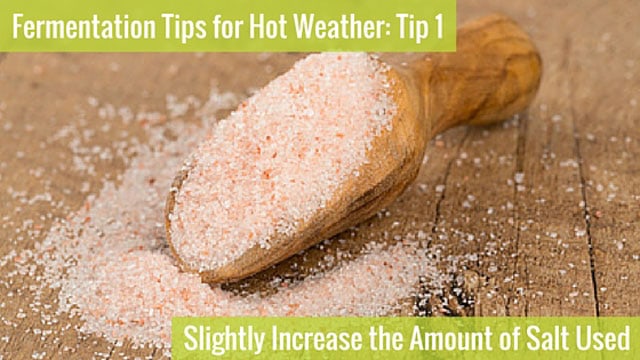
You can slightly increase the amount of salt used to slow down the fermentation a bit. Be aware, however, that too much salt will inhibit good bacteria so don’t go overboard.
Try a rounded tablespoon instead of a level tablespoon when measuring. If you’re weighing salt, test a batch with 2.5% instead of 2%.
How much salt you use and which salt you use makes a difference.
What is the Best Salt to Use When Making Fermented Sauerkraut?
How Much Salt Do I Use to Make Sauerkraut?
[su_dropcap style=”simple” size=”1″ class=”green”]2[/su_dropcap]
Ferment for a Shorter Time Period

During ideal temperature conditions, 3-4 weeks is the normal length of time to ferment.
During hot weather, your ferment can be done in as little as 5 days. Check it at this point to see if it has fermented to your liking. If it has, put it in your refrigerator. If not, taste again in a few more days.
Ideally, however, we’re going to find – or make – a cooler spot for your ferment so it can properly progress through all three stages of fermentation.
Read more about how long to ferment sauerkraut:
How Long to Ferment Sauerkraut?
[su_dropcap style=”simple” size=”1″ class=”green”]3[/su_dropcap]
Find a Cooler Location
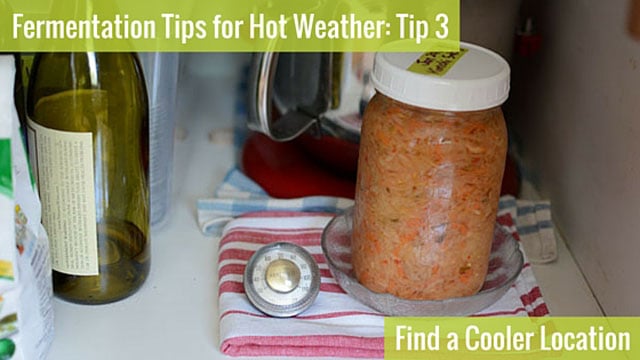
Survey your home for a better spot. You might be pleasantly surprised to find a little microclimate in your home that will do the trick, which is why a thermometer is so helpful.
You will want a spot away from sunlight and heat-producing appliances. That refrigerator or gas stove with pilot light produces more heat than you realize.
- Garage?
- Basement?
- Unused spare room?
- A low cupboard along an inside wall?
- Old dorm-sized refrigerator?
Turn the thermostat to its warmest setting and monitor with a thermometer to ensure it is not below 60° F (16° C).
And, don’t place your ferment in here until after the first few days of fermentation when you want a 65-72° F (18–22° C) temperature range.
Be careful with these out of the way locations, though. It’s easy to forget your ferment when it’s tucked away. Out of sight, out of mind.
As a reminder, leave an empty jar in plain sight in your kitchen with a note on it: “Check My Sauerkraut!”
[su_dropcap style=”simple” size=”1″ class=”green”]4[/su_dropcap]
Use the Air Conditioner or a Fan
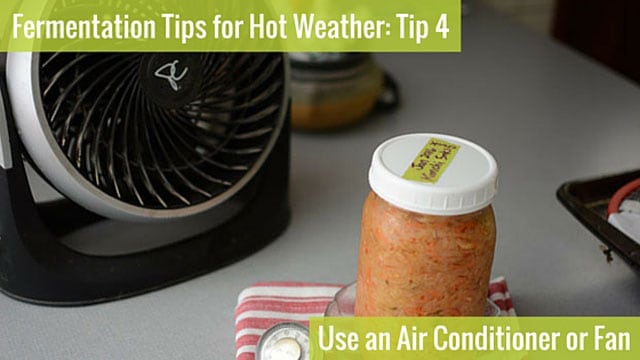
If your home is air-conditioned, it should be cool enough. If not, check a spot close to the air conditioner
Or, place a fan near your ferment. Moving air through a room will lower the temperature.
[su_dropcap style=”simple” size=”1″ class=”green”]5[/su_dropcap]
Take Advantage of Evaporative Cooling: The Wet T-Shirt Method

For the wet t-shirt method, wrap your jar in a wet towel or t-shirt to take advantage of evaporative cooling.
The Brew: How to Home Brew Beer Magazine website goes into greater detail on how to use the wet t-shirt method.
Wet T-Shirt Method
“If you don’t have the room or the budget for a brewing fridge, there is a low-tech way of cooling your ferment. If you place a wet T-shirt over the ferment, it will cool down the wort inside the ferment. The wet T-shirt method works because as water evaporates from the T-shirt, heat goes with it. To keep the T-shirt wet, set a pan of water next to the ferment and dip part of the shirt in the water. As water evaporates from the shirt, water from the glass will wick up to replace it.”
“You can increase the cooling power of the T-shirt method by pointing a fan at the ferment. The air flowing past the ferment displaces the air next to the ferment. This air, laden with water vapor from evaporation, is replaced by drier air. This allows further water to evaporate from the T-shirt. And, of course, you can always add ice to the water pan.”
[su_dropcap style=”simple” size=”1″ class=”green”]6[/su_dropcap]
Insulate Your Ferment

Wrap you ferment with an old sweater or piece of wool blanket. This can be a bit messy however if brine seeps out of the jar. You’ll have to wash the sweater or blanket afterward.
Yemoos Nourishing Cultures sells wool jar insulators. Stylish and handmade in the United States. You can even go DIY and make your own. Cut off a sleeve from an old wool sweater to slip over your jar of fermenting sauerkraut.
[su_dropcap style=”simple” size=”1″ class=”green”]7[/su_dropcap]
Use an Ice Chest to Make a Cool Chamber
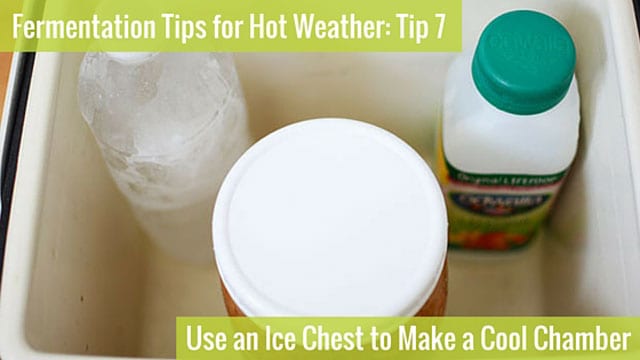
Use an ice chest filled with a few small juice-sized bottles of ice. Monitor the temperature in there. You don’t want to use too much ice and end up with it being too cold.
Place the ice next to but not directly touching your fermenting sauerkraut.
[su_testimonial name=”Jennifer – Queensland, Australia” photo=”https://www.makesauerkraut.com/wp-content/uploads/2014/09/avatar-F16.png”]It’s been a while since I emailed you, but wanted to tell you my sauerkraut was perfect. We have almost eaten the whole 30lb! Fermenting it in the crock in the ice chest ( because of our very hot summer here in Qld Australia) and exchanging two frozen bottles of water out every day seem to work like a charm ( for 2 months ). My husband says it’s the best sauerkraut he has ever eaten and he was raised in the USA eating lots of kraut.[/su_testimonial]
[su_dropcap style=”simple” size=”1″ class=”green”]8[/su_dropcap]
Use an Ice Chest to Make a Swamp Cooler
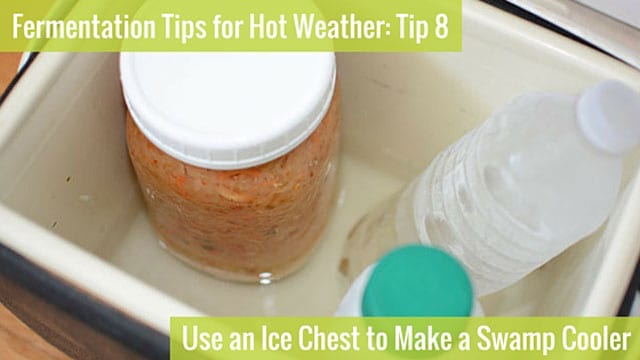
Place your jar of sauerkraut in a cooler filled with water 1/4 to 1/3 of the way up your jars. Throw cold packs or jugs of ice in the water. Change out your cold packs or jugs 1-2 times a day.
[su_dropcap style=”simple” size=”1″ class=”green”]9[/su_dropcap]
Set Your Ferment on a Slab of Stone or Marble
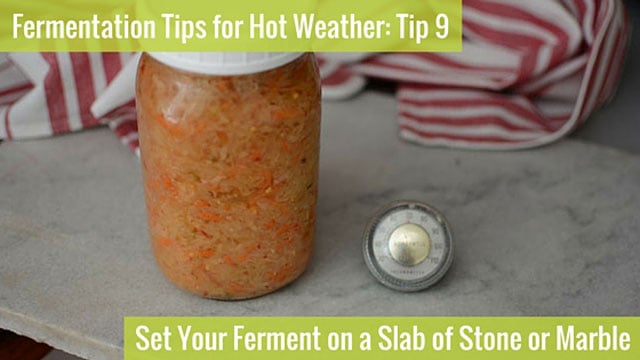
A marble or stone slab stays cool for a long time which is why they’re used to temper chocolate – in my household! – or are used by bakers when rolling out the butter-rich dough.
You can purchase a slab at a tile store or at a shop where they make marble or stone countertops. You might even luck out and get an odd sized, or “defective” piece on the cheap. Place the slab in your refrigerator at night to chill it and used in during the day to place under your jar of fermenting sauerkraut.
[su_dropcap style=”simple” size=”1″ class=”green”]10[/su_dropcap]
Ferment Seasonally

You may have to work your way up to this one. I did.
When first learning to make sauerkraut, I fermented as I needed to and when I could find the time. I didn’t care if it was the middle of summer or if we were deep into winter. When one jar was about half eaten, I would start another jar fermenting.
Then I progressed to fermenting in a 10-liter crock, starting a new batch when there was just a jar or two of sauerkraut left. Again, the time of year didn’t matter.
Lastly, I moved to an area where my local farmer’s market had plenty of fall cabbage and switched to fermenting only during the fall and early winter.
What a wonderful way to be motivated to put up the bounty. The fresh cabbage produced all the brine needed. Prices for cabbage were good. The cabbage wasn’t shipped hundreds of miles and I was soon able to convince the farmers I got to know to grow the varieties of cabbage that make superior sauerkraut.
A winning combination.
[su_dropcap style=”simple” size=”1″ class=”green”]11[/su_dropcap]
Avoid the Use of Starter Cultures
I’ve seen recommendations to use starter cultures when fermenting in hot weather. I recommend against using them. In my experience, I find they speed up the fermentation process, exactly opposite of what we’re trying to do. This happens because you’re adding more bacteria than is necessary.
These fermentation tips should get you started on cooling down your fermenting sauerkraut. Share your successes, failures or ideas in the Comment Section, below.

Last update on 2024-07-27 / Affiliate links / Images from Amazon Product Advertising API

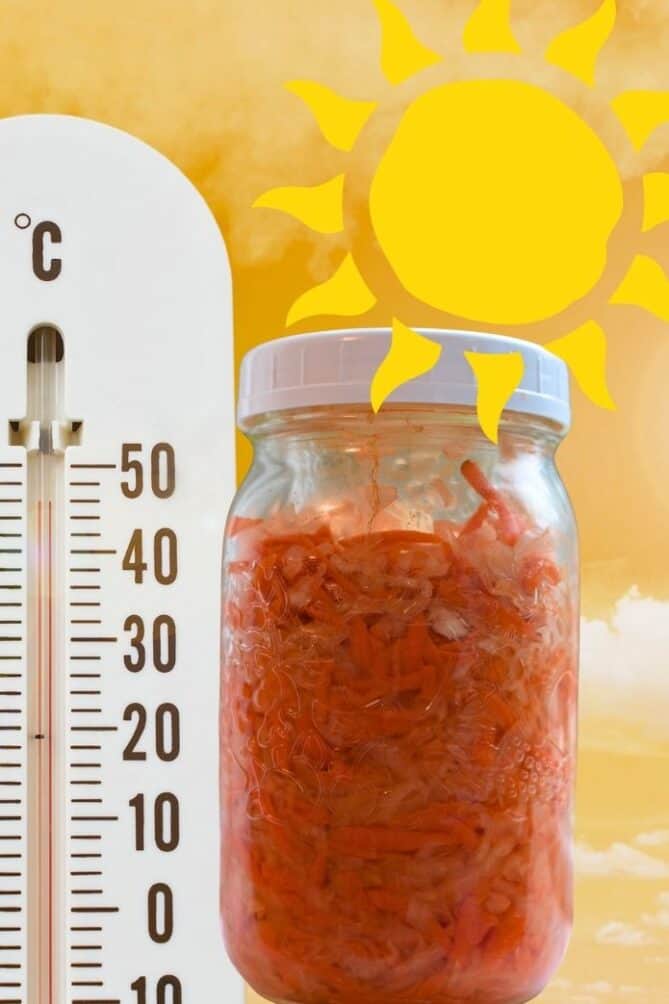

 This post may contain affiliate links which won’t change your price but will share some commission.
This post may contain affiliate links which won’t change your price but will share some commission.